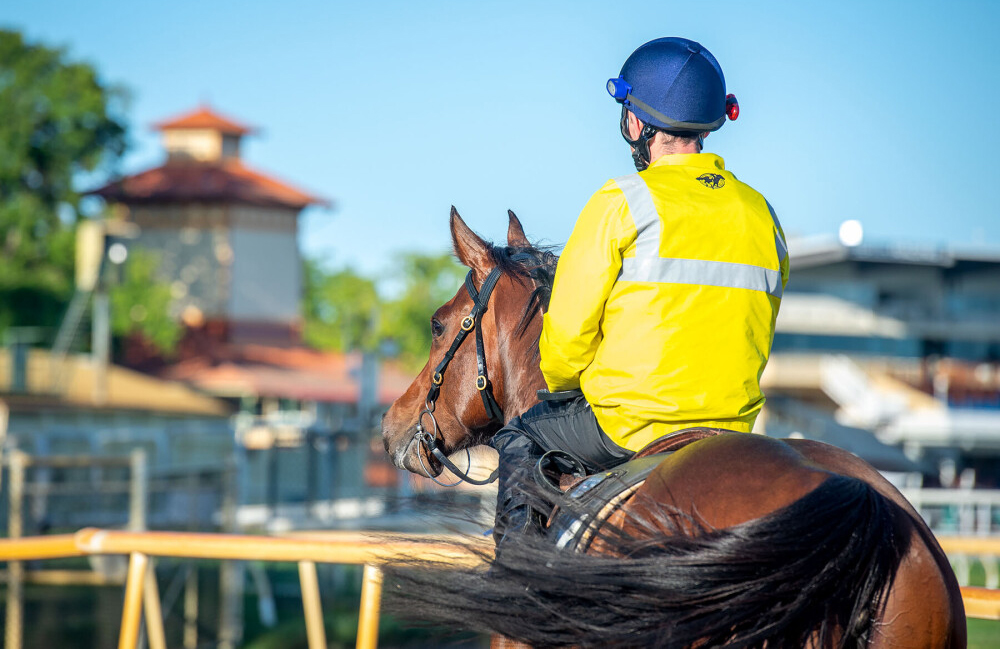Feeding the OTT Thoroughbred

Retired racehorses can have great potential as equestrian horses in their life after racing. Training and educating an OTT horse can be both rewarding and challenging. Finding the right dietary management plays a very important role in making that transition a smooth one. Here we take a look at some of the feeding considerations for these horses.
During racing, horses are trained at exercise levels that require a diet formulated to fuel fast-twitch muscle fibres and support fast, short bouts of intense exercise. This type of diet typically involves grains, blended with some fat and fibre. Often, the grain portion can be up to 50% of the ration. These diets are higher in non-structural carbohydrates (NSC) in order to support the intensity of the exercise and replenish muscle glycogen. However, once a horse finishes racing, and their workload decreases, their feed and energy requirements change dramatically and the feeding plan should reflect this.
Start with the Basics
Fibre should form the base of the diet for horses in light work or having a spell/let-down after racing. Providing horses with access to ad lib hay is ideal. Often, OTT horses will need to gain weight. Free access to hay and fibre will assist with this. However, sometimes it isn’t that simple. These horses can be fussy and not eat as much fibre as we’d like, or we may need to consider which type of hay/fibre combinations to use to best suit the horse’s needs. Oaten hay can be great for assisting with body condition, and is usually very palatable. However, horses that have highly strung temperaments may benefit from a lower NSC variety such as meadow hay. Sometimes a blend of both can achieve the sweet spot between NSC content and palatability.
Adding Hard Feeds
After addressing fibre as the foundation of the diet, it’s time to look at hard feeds. Many OTT horses will require supplementary feeding to achieve and maintain good body condition. As a breed, thoroughbreds generally have a higher metabolism and require greater quantities of feed than ‘easy-keepers’ such as warmbloods. To address this, making use of low NSC, low grain or grain-free feeds can be a good way to meet those requirements without ‘heating up’ the temperament. Fats are also an excellent addition to the diet. Fats are energy dense, so provide calories in a more concentrated way than fibre and grain. They are also a ‘cool’ feed and reduce the ‘fizz’ for a highly strung or anxious thoroughbred. Pegasus Liberty is an ideal feed for OTT horses. It is cereal grain-free and contains a blend of fats and fibres to meet energy requirements, whilst also providing all the essential proteins, vitamins and minerals to support optimal condition. Liberty has an excellent track record (pardon the pun!) for putting condition on OTT horses and is a popular go to for re-trainers. Horses can be fed between 1.5kg and 4kg depending on their body condition. Pegasus Coolmax is also another tried and tested feed. It’s low-grain formula makes it ideal for OTT horses that require cool energy and body condition and require a higher feeding quantity, of around 2-5kg per day. As an added benefit, all Pegasus feeds contain KER BMC –research-proven to support bone mineral content, whilst providing both gastric and hindgut buffering.
General Health
As with all horses, routine health assessment should include dental care, worm burden assessment, sand burden assessment, and gastro-intestinal health status. Some OTT horses may display anxious behaviour, or suffer from gastro-intestinal disturbances. After setting up a diet including plenty of roughage, and balanced with a concentrate including fats, vitamins and minerals, the addition of a digestive buffer may help. Equi-Shure, targeted at the hindgut, may assist with stressy and nervous behaviour. EquiShure supplies a time-released balancer to help neutralise acid build up and help maintain a stable hindgut environment, which encourages proper digestion and absorption of nutrients.
For help developing a feeding plan for your OTT horse, contact our Equine Nutrition Advisor, Michelle Meylan.


